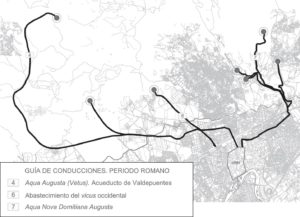
Water: aqueducts, sewage systems and baths

The monumentalization of the new Colonia Patricia during the 1st century AD involved the creation of several hydraulic infrastructures, for the water supply and for the improvement of the urban image. The aqueducts would provide water for public fountains, the bath complexes, the industries and the homes of the citizens who could afford it.

The first aqueduct documented until now is the Aqua Augusta or Aqua Vetus. It was made of Roman concrete (opus caementicium) and waterproofed inside with a water-repellent coating (opus signinum). At some points it was provided with an ingenious system of rebound wells (spiramina) and arcuationes that allowed overcoming big drop differences, avoiding great slopes on its design. Centuries later, it was reused for the supply of Madinat al-Zahra.

Some decades after, the Aqua Nova Domitiana Augusta was built. Its remains have been located northeast of the city, next to the Arroyo Pedroche. It was also made of opus caementicium, but without coating inside. A third aqueduct was added soon, for the water supply of the Western vicus. Some literary texts refer to him with the suggestive name of Fontis Aureae Aquaeductus. Part of its remains can be seen today in the Bus Station.

For the water drainage, the streets of the Roman city were provided with a very effective sewer network. Some of them can be highlighted, such as the cloaca maxima, which ran under the Cardo maximus located in the current Blanco Belmonte street; the one discovered under the Alfonso XII street, still in operation; or the three partially preserved on Antonio Maura street, which drained the amphitheater and its great access avenue.
Bibliography
APARICIO SÁNCHEZ, L. (1994): “Nuevas aportaciones sobre el Aqua Vetus Augusta y la necrópolis occidental de Colonia Patricia Corduba“, AAC 5, Córdoba, 155‑179.
BERMÚDEZ, J. M.; HIDALGO, R. y VENTURA, A. (1991): “Nuevos testimonios epigráficos referentes al abastecimiento de agua pública a la Colonia Patricia ” Anales de Arqueología Cordobesa 2, 291-308.
BORREGO DE LA PAZ, J. D. (2008): “La Entrada del “Agua Augusta Vetus a Colonia Patricia”: Notas para el abastecimiento de agua a la Córdoba romana”, AAC 19, pp. 99-124.
CASTILLO PÉREZ DE SILES, F. (2003): “Las termas” en VAQUERIZO GIL, D. (Dir.): Guía Arqueológica de Córdoba, Córdoba, pp.53-55.
GARCÍA MATAMALA, B.; PIZARRO BERENGENA, G.; VARGAS CANTOS, S. (2009): “Evolución del trazado urbanístico de Córdoba en torno al eje Tendillas-Mezquita. Hallazgo de una cisterna romana de abastecimiento de agua”, Anejos de AAC 2, Córdoba.
HIDALGO PRIETO, R.; VENTURA VILLANUEVA, A.; BERMÚDEZ CANO, J. M. (1991): “Nuevos testimonios epigráficos referentes al abastecimiento de agua pública a la Colonia Patricia”, AAC, 2, pp. 291-308.
MORENA LÓPEZ, J. A. (1994): “Nuevas aportaciones sobre el Aqua Vetus Augusta y la necrópolis occidental de Córdoba” Anales de Arqueología Cordobesa 5, 155-180.
MORENO ALMENARA, M. et alii (1997): “Nuevos datos sobre el abastecimiento de agua a la Córdoba romana e islámica” Arte, Arqueología e Historia, 4, 13-23.
PIZARRO BERENGENA, G. (2003): “Una propuesta interpretativa en la ciudad de Córdoba. Los acueductos romanos de Córdoba y su papel en la Historia de la ciudad” Actas de las VII Jornadas Andaluzas de Difusión del Patrimonio Histórico, pp. 227-236.
PIZARRO BERENJENA, G. (2013): El abastecimiento de agua a Córdoba. Arqueología e historia. Universidad de Córdoba. Servicio de Publicaciones. Córdoba.
RODRÍGUEZ NEILA, J. F., (1988), “Aqua pública y política municipal romana”, Gerión, 6, Madrid, pp. 223-252.
STYLOW, A. U. (1987): “Acueductos romanos de Córdoba” Corduba Archaeologica 13 (1982-83), 40-45.
VAQUERIZO GIL, D. (2003): Guía Arqueológica de Córdoba, Córdoba.
VENTURA VILLANUEVA, A. (1993): El abastecimiento de agua a la Córdoba romana I: El acueducto de Valdepuentes. Córdoba.
VENTURA VILLANUEVA, A. (1994): “Los acueductos de la Colonia Patricia Corduba” La ciudad en el mundo romano. Actas del XIV Congreso Internacional de Arqueología Clásica. Vol. 2. Comunicaciones, Tarragona, 422-423.
VENTURA VILLANUEVA, A. (1996): El abastecimiento de agua a la Córdoba romana II. Acueductos, ciclo de distribución y urbanismo. Córdoba.
VENTURA VILLANUEVA, A. (2002): “Los acueductos romanos de Córdoba y su rehabilitación omeya”, Empúries, 53, pp. 113-128.
VENTURA VILLANUEVA, A.; PIZARRO BERENGENA, G. (2010): “El Aqua Augusta (acueducto de Valdepuentes) y el abastecimiento de agua a Colonia Patricia Corduba, investigaciones recientes (2000-2010)”, Las técnicas y las construcciones en la ingeniería romana, pp. 175-204.

